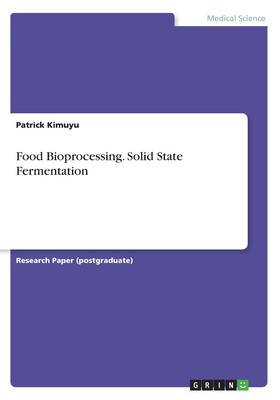
- We will send in 10–14 business days.
- Author: Patrick Kimuyu
- Publisher: GRIN Verlag
- Year: 2017
- Pages: 20
- ISBN-10: 3668575517
- ISBN-13: 9783668575516
- Format: 17.8 x 25.4 x 0.1 cm, minkšti viršeliai
- Language: English
- SAVE -10% with code: EXTRA
Reviews
Description
Research Paper (postgraduate) from the year 2016 in the subject Health - Public Health, grade: 1, Egerton University, language: English, abstract: For centuries, fermentation has been extensively applied in the production of distinct substances that remain highly beneficial to industries and people, with its increasing techniques gaining immense significance due to their environmental and economic benefits. According to recent studies, solid state fermentation is considered as the cheapest and environmentally responsive approach for the production of value-added industrial products, for example, enzymes biofuels and even nutrient enriched animal feeds. Solid state fermentation may be described as the growth and/or cultivation of micro-organisms under controlled conditions without the presence of free liquid for desired products development. It is an ancient technique that utilizes solid substrates such as bagasse, paper pulp and bran. A key benefit of using such substrates is that waste substances that are rich in nutrients can be recycled as substrates, and due to the slow and steady substrate utilization, the substrate may be used for long fermentation periods. As a result, this technique sustains controlled nutrients release. Significantly, solid-state fermentation technique works best in techniques that involve fungi as well as micro-organisms requiring less moisture content since the moisture required for the growth of microbes exists in absorbed states or in composite with solid matrix. However, even though this technique has diverse advantages, especially compared with submerged fermentation technique, there are certain processes in which SSF may not be used, for example, in bacterial fermentation or in processes that involve organisms requiring high water activity. The main aim of this paper is, thus, describing solid-state fermentation as a technique for the production of bioactive compounds.
EXTRA 10 % discount with code: EXTRA
The promotion ends in 23d.01:38:45
The discount code is valid when purchasing from 10 €. Discounts do not stack.
- Author: Patrick Kimuyu
- Publisher: GRIN Verlag
- Year: 2017
- Pages: 20
- ISBN-10: 3668575517
- ISBN-13: 9783668575516
- Format: 17.8 x 25.4 x 0.1 cm, minkšti viršeliai
- Language: English English
Research Paper (postgraduate) from the year 2016 in the subject Health - Public Health, grade: 1, Egerton University, language: English, abstract: For centuries, fermentation has been extensively applied in the production of distinct substances that remain highly beneficial to industries and people, with its increasing techniques gaining immense significance due to their environmental and economic benefits. According to recent studies, solid state fermentation is considered as the cheapest and environmentally responsive approach for the production of value-added industrial products, for example, enzymes biofuels and even nutrient enriched animal feeds. Solid state fermentation may be described as the growth and/or cultivation of micro-organisms under controlled conditions without the presence of free liquid for desired products development. It is an ancient technique that utilizes solid substrates such as bagasse, paper pulp and bran. A key benefit of using such substrates is that waste substances that are rich in nutrients can be recycled as substrates, and due to the slow and steady substrate utilization, the substrate may be used for long fermentation periods. As a result, this technique sustains controlled nutrients release. Significantly, solid-state fermentation technique works best in techniques that involve fungi as well as micro-organisms requiring less moisture content since the moisture required for the growth of microbes exists in absorbed states or in composite with solid matrix. However, even though this technique has diverse advantages, especially compared with submerged fermentation technique, there are certain processes in which SSF may not be used, for example, in bacterial fermentation or in processes that involve organisms requiring high water activity. The main aim of this paper is, thus, describing solid-state fermentation as a technique for the production of bioactive compounds.


Reviews